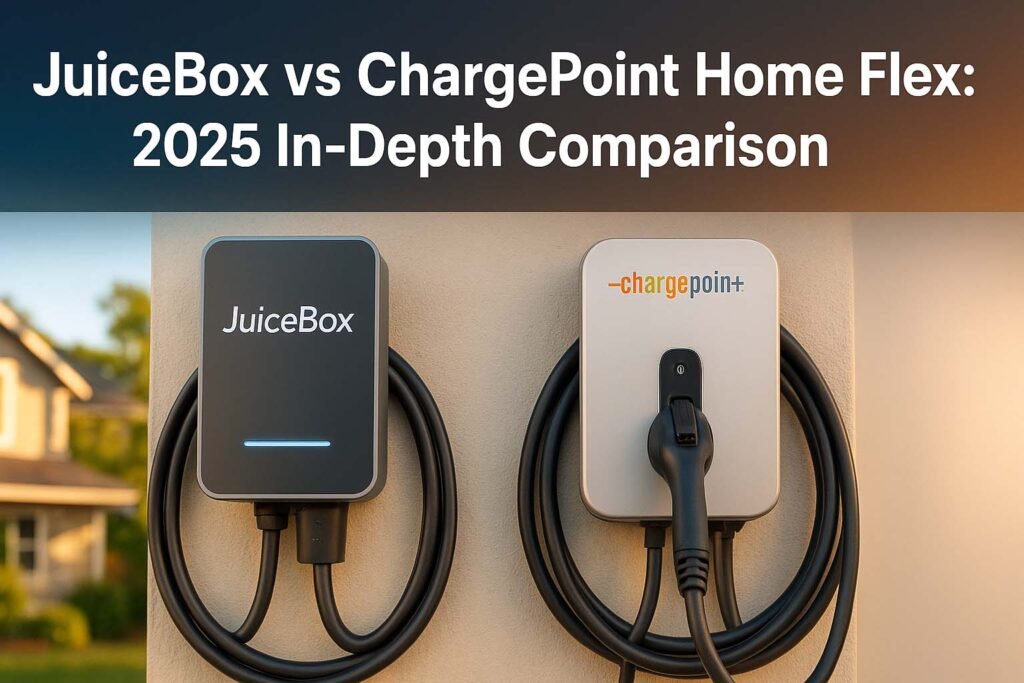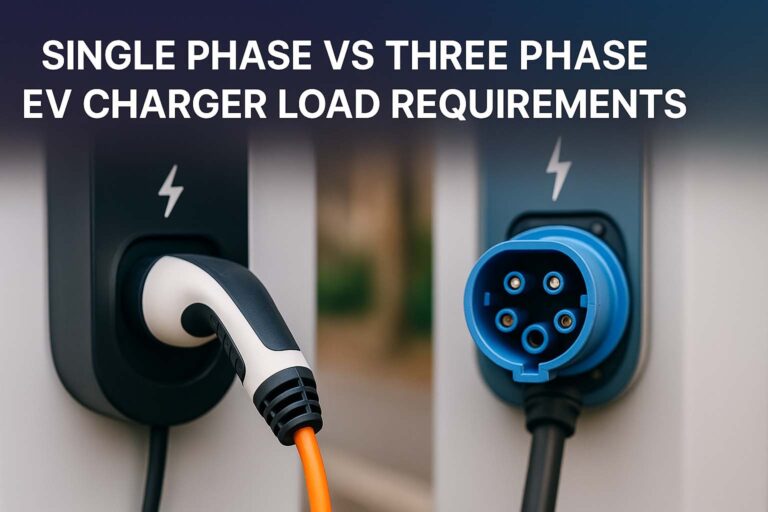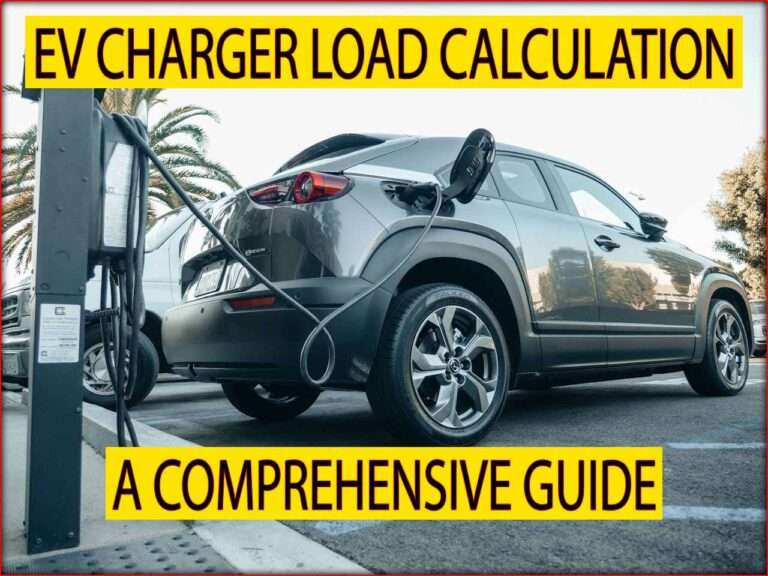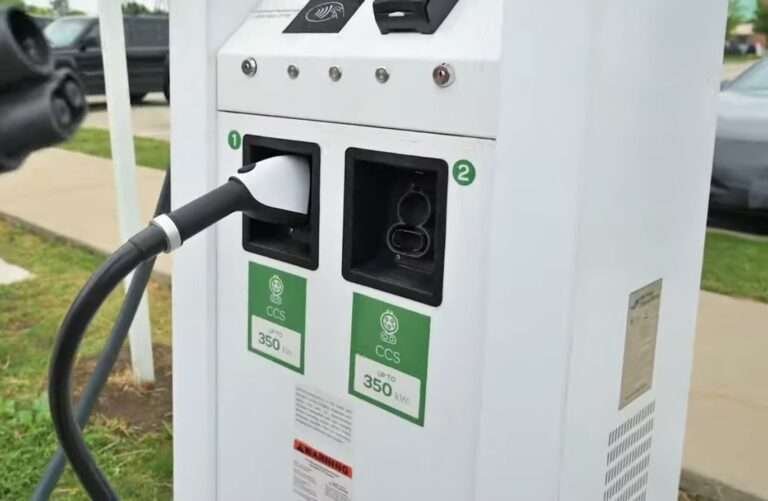JuiceBox vs ChargePoint Home Flex: 2025 In-Depth Comparison
The electric vehicle (EV) market is growing fast, and with it comes the rising demand for reliable home charging stations. Two of the most popular choices in 2025 are the JuiceBox 40/48 by Enel X and the ChargePoint Home Flex. Both chargers are considered premium options for EV owners who want faster charging speeds, smart connectivity, and flexibility for future EV upgrades. Yet, many new EV owners face the same question: JuiceBox vs ChargePoint Home Flex – which one is better for your home in 2025?
Table of Contents
Table of Contents

This article provides a comprehensive and human-friendly comparison of these two chargers. Instead of drowning you in technical jargon, we’ll break it down into easy-to-read sections covering performance, design, features, installation, compatibility, and cost. The goal is to give you the most valuable information so you can make the right decision for your home charging needs.
Before diving into the details, here are the key takeaways to keep in mind as you compare JuiceBox and ChargePoint.
Key Takeaways:
- Both JuiceBox and ChargePoint Home Flex offer up to 50-amp charging, making them suitable for nearly every EV in 2025.
- JuiceBox is slightly more affordable and comes with advanced scheduling and energy monitoring features.
- ChargePoint has stronger app integration, especially for public charging networks, making it a great choice for frequent travelers.
- Installation costs are similar, but JuiceBox may be easier to set up for certain households.
- The final choice depends on whether you value app ecosystem (ChargePoint) or energy monitoring and price savings (JuiceBox).
JuiceBox vs ChargePoint Home Flex: Charging Power and Speed
When comparing EV chargers, charging speed is the first thing most buyers look at. In this regard, both JuiceBox and ChargePoint Home Flex perform at the top of their class.
The JuiceBox 40 delivers up to 40 amps (9.6 kW), while the JuiceBox 48 delivers 48 amps (11.5 kW). The ChargePoint Home Flex is flexible in amperage and can provide between 16 to 50 amps depending on your home wiring setup. This means that both chargers can add about 25–37 miles of range per hour, depending on your EV.
Know more about Hardwired vs Plug In EV Charger: Which is Better for Your Home?
Comparison Table: Charging Performance
| Feature | JuiceBox 40 | JuiceBox 48 | ChargePoint Home Flex |
|---|---|---|---|
| Maximum Amps | 40A | 48A | 50A |
| Power Output | 9.6 kW | 11.5 kW | 12 kW |
| Typical Range Added | 25–30 miles/hr | 30–37 miles/hr | 30–37 miles/hr |
In real-world use, most EVs today cannot even take advantage of more than 40 amps, so the difference between these chargers is often small. However, if you are planning for the future, the ChargePoint’s 50A capacity gives a slight edge.
JuiceBox vs ChargePoint Home Flex: Design and Build Quality
Design plays a big role in daily usability. Both chargers are sleek, but their approaches differ.
The JuiceBox has a modern, compact design with an LED status indicator and a front-facing cable holster. It is wall-mounted and comes with a 25-foot charging cable. The design feels robust but also practical, with weatherproofing for both indoor and outdoor installations.
The ChargePoint Home Flex also features a premium build with a more minimalist look. Its cable management is slightly more refined, with a flexible cord that is easier to handle. Like JuiceBox, it includes a 23–25-foot cable and is rated for outdoor installation.
In terms of durability, both are rated NEMA 4 weatherproof, meaning they can handle rain, snow, and dust. Both units feel sturdy and built to last for years of charging cycles.
Know more about Single Phase vs Three Phase EV Charger Load Calculator
JuiceBox vs ChargePoint Home Flex: Smart Features and App Integration
One of the biggest reasons EV owners choose smart chargers is the ability to monitor, schedule, and control charging remotely.
JuiceBox comes with the JuiceNet app, which allows you to:
- Set charging schedules to take advantage of off-peak electricity rates.
- Monitor energy usage in real-time.
- Receive alerts when charging is complete.
- Integrate with smart home systems like Alexa and Google Assistant.
ChargePoint Home Flex, on the other hand, uses the ChargePoint app, which is arguably the most powerful charging app in the EV industry. Beyond managing home charging, the app gives you access to the entire ChargePoint public charging network, which is one of the largest in North America. This is a huge advantage for drivers who frequently use public chargers.
Know more about How to Calculate Load for Multiple EV Chargers in Apartment Buildings
Comparison Table: App Features
| Feature | JuiceBox (JuiceNet App) | ChargePoint Home Flex (ChargePoint App) |
|---|---|---|
| Remote Control | Yes | Yes |
| Energy Monitoring | Yes | Limited |
| Scheduling | Yes | Yes |
| Smart Home Integration | Alexa, Google Assistant | Alexa, Google Assistant |
| Public Charging Network Access | No | Yes |
If you value tracking your home electricity use and optimizing your bills, JuiceBox is better. If you want seamless access to both home and public charging, ChargePoint is the winner.
JuiceBox vs ChargePoint Home Flex: Installation and Setup
Both chargers require professional installation if you plan to use them at their full capacity (40A or more). They can be hardwired for a cleaner look or plugged into a NEMA 14-50 outlet for easier setup.
JuiceBox is slightly more flexible for DIY installations if you already have a 240V outlet installed. ChargePoint requires setup through its app, which guides you through amperage configuration.
In terms of cost, installation can range between $500–$1,500 depending on your electrical panel capacity and wiring needs. Both chargers are eligible for federal tax credits and local incentives in 2025, which can significantly reduce upfront costs.
JuiceBox vs ChargePoint Home Flex: Compatibility and Future-Proofing
Compatibility is rarely an issue since both chargers use the universal J1772 connector, which works with all EVs sold in North America except Tesla. Tesla drivers can still use either charger with the included J1772 adapter.
Future-proofing is where ChargePoint has a small edge. Its maximum 50A output ensures it can handle even the largest EV batteries coming to market in the next decade. JuiceBox 48 also does very well here, but the 40A version may feel limited if you upgrade to a high-capacity EV later on.
Know more about 7kW EV Charger Cost: A Detailed Guide
JuiceBox vs ChargePoint Home Flex: Cost and Value in 2025
Price is one of the deciding factors for most buyers.
- JuiceBox 40 typically sells around $649–$699.
- JuiceBox 48 is priced between $699–$749.
- ChargePoint Home Flex usually costs about $749–$799.
While prices can fluctuate with promotions, JuiceBox generally offers slightly better value. It is especially attractive for homeowners who want energy monitoring features without spending extra. ChargePoint, however, justifies its higher price with better app integration and access to its public network.
Comparison Table: Pricing and Value
| Model | Typical Price (2025) | Best For |
|---|---|---|
| JuiceBox 40 | $649–$699 | Budget-conscious users with moderate charging needs |
| JuiceBox 48 | $699–$749 | Users who want future-proof charging at a fair price |
| ChargePoint Home Flex | $749–$799 | Drivers who value app ecosystem and public charging access |
JuiceBox vs ChargePoint Home Flex: Which One Should You Buy in 2025?
The final choice depends on your personal needs.
Choose JuiceBox if:
- You want the most affordable option with strong features.
- Energy monitoring and scheduling matter to you.
- You already have a reliable public charging routine outside of ChargePoint’s network.
Choose ChargePoint Home Flex if:
- You value seamless app integration with public charging.
- You want the most future-proof home charger at 50A.
- You don’t mind paying a little extra for a premium ecosystem.
Both options are excellent, and neither will leave you disappointed. The real difference comes down to ecosystem and priorities. JuiceBox is like the best value pick, while ChargePoint is the premium ecosystem pick.
Know more about Portable EV Charger Level 2: A Comprehensive Guide
Final Thoughts
In the debate of JuiceBox vs ChargePoint Home Flex, there is no wrong choice. Both chargers are reliable, future-proof, and backed by strong companies in the EV space.
If saving money while still enjoying advanced smart features is your top goal, go with JuiceBox. If long-term flexibility, app ecosystem, and integration with public charging are more important, ChargePoint Home Flex is the way to go.
As EV adoption continues to rise in 2025 and beyond, choosing the right home charger is one of the smartest investments you can make. With either of these chargers, you’ll enjoy faster, smarter, and more convenient charging right at home.
Follow Us on Social:
Subscribe our Newsletter on Electrical Insights to get the latest updates in Electrical Engineering.
#JuiceBoxVsChargePoint, #ChargePointHomeFlex, #JuiceBoxCharger, #EVCharging2025, #SmartEVCharger, #HomeEVCharging, #EVChargerComparison, #ElectricVehicleCharger, #ChargePointVsJuiceBox, #EVChargerReview, #EVChargerGuide, #BestEVCharger2025, #EVChargingSolutions, #EVHomeCharging, #EVChargerBattle



![Best EV Chargers for Hotels & Guest Accommodations [Commercial Grade] 4 Best EV Chargers for Hotels & Guest Accommodations [Commercial Grade]](https://azadtechhub.com/wp-content/uploads/2025/10/Best-EV-Chargers-for-Hotels-Guest-Accommodations-Commercial-Grade-768x512.jpg)


